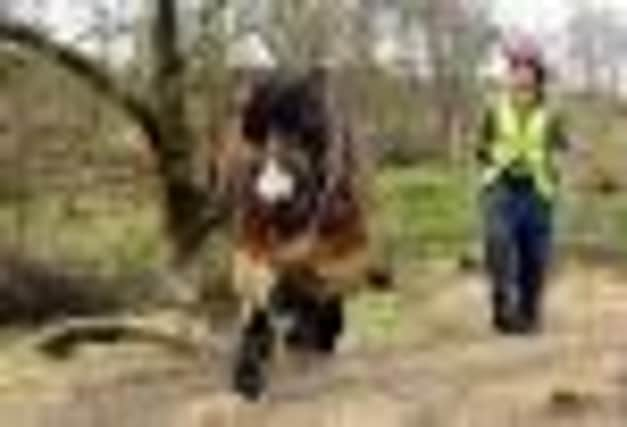Horses ride to the rescue of ancient woodland


But the craft of horse logging is making a comeback as conservationists look to ancient forestry techniques to carry out projects in some of the nation’s woodlands.
And among the new recruits helping forge a new future for horse logging is Steffi Schaffler, based in the North York Moors and one of three new apprentices nationally who are undertaking a three-year training programme.
Advertisement
Hide AdAdvertisement
Hide AdThe British Horse Loggers Charitable Trust, which has the Prince of Wales as its patron, has organised the apprenticeship scheme amid a growing demand for environmentally-friendly – and cheaper – forestry techniques.
Horses are now regularly used instead of machinery to clear woods across the UK, including areas in Yorkshire and the Lake District as well as in Scotland. The animals are also used on archaeological sites, where heavy machinery cannot be employed for fear of destroying historic remains.
Ms Schaffler, 33, who has bought a 12-year-old Ardennes horse called Lisa, claimed the use of the animals to help thin forests and transport logs is often a far more financially-viable option, especially in smaller areas of woodland.
She said: “The horses are often able to get into far smaller areas and gaps between the trees than the modern machinery. And people love it when they can see the horses working in the forests – it is a taste of a time many people thought had gone.”
Advertisement
Hide AdAdvertisement
Hide AdForestry chiefs believe the use of horse-logging will prove invaluable in helping restore parts of the nation’s ancient woods, which have been dubbed Britain’s rain forests. Many of the ancient woodlands, which are defined as those which have been continuously forested since at least the 1600s when the first reliable maps were produced, are seen as irreplaceable for many plants and animals.
Evocative species like wood anemone and dog’s mercury typically grow in the woodlands, but many areas are in a poor condition. Some are overgrown, dark and moribund, while others have been planted with conifers.
Ian Everard, from the Forestry Commission, claimed horse logging could play a “big role” in helping restore the woodlands which are often on difficult terrain or in environmentally sensitive locations. The animals have already been used to remove hundreds of tonnes of timber across the country, allowing light to penetrate the overgrown forest canopies to give native species a chance to thrive.
Ms Schaffler, who came to the UK in 2005 from Munich and now lives in Castleton in North Yorkshire, switched from organic farming in Scotlandto win a place on the apprenticeship scheme, which also has recruits in Herefordshire and Cumbria.
Advertisement
Hide AdAdvertisement
Hide AdShe decided on a career change to pursue a long-held ambition of working with horses, and undertook a two-week trial in North Yorkshire last year.
She is now working under the supervision of Chris Wadsworth, from Guisborough in North Yorkshire, who himself has 21 years of experience as a woodsman. And while Mr Wadsworth works with a 10-year-old heavy horse, Ouragan, which is a Percheron, or French Draught, his apprentice maintains the craft is not solely down to animal brute force. Ms Schaffler said: “While people often think that you need to use a heavy horse, an Exmoor pony can also be equally as talented. The main thing is that the horse can stand still – and trusts their owner completely. I know that my horse would do anything for me, and once you have that bond, it makes the job a lot easier.”
Since she started her apprenticeship, Ms Schaffler has been involved in projects across the country, including work in Hexham in Northumberland and Edinburgh.
She has also helped clear and restore woodland in Pickering in North Yorkshire as well as Kippax in Leeds.
Advertisement
Hide AdAdvertisement
Hide AdMr Wadsworth maintained the ancient art of horse logging was becoming an increasingly important element of forestry work as more woodland owners realised it remained a viable alternative to the use of heavy machinery.
He said: “Although it’s a very old way of hauling timber, horse logging still has a bright future. Not only is it gentler on ground flora, but sometimes it can be the most economic or indeed the only viable option of working a wood. So it really is important that we have young loggers coming forward and Steffi and her horse are already pretty proficient.”